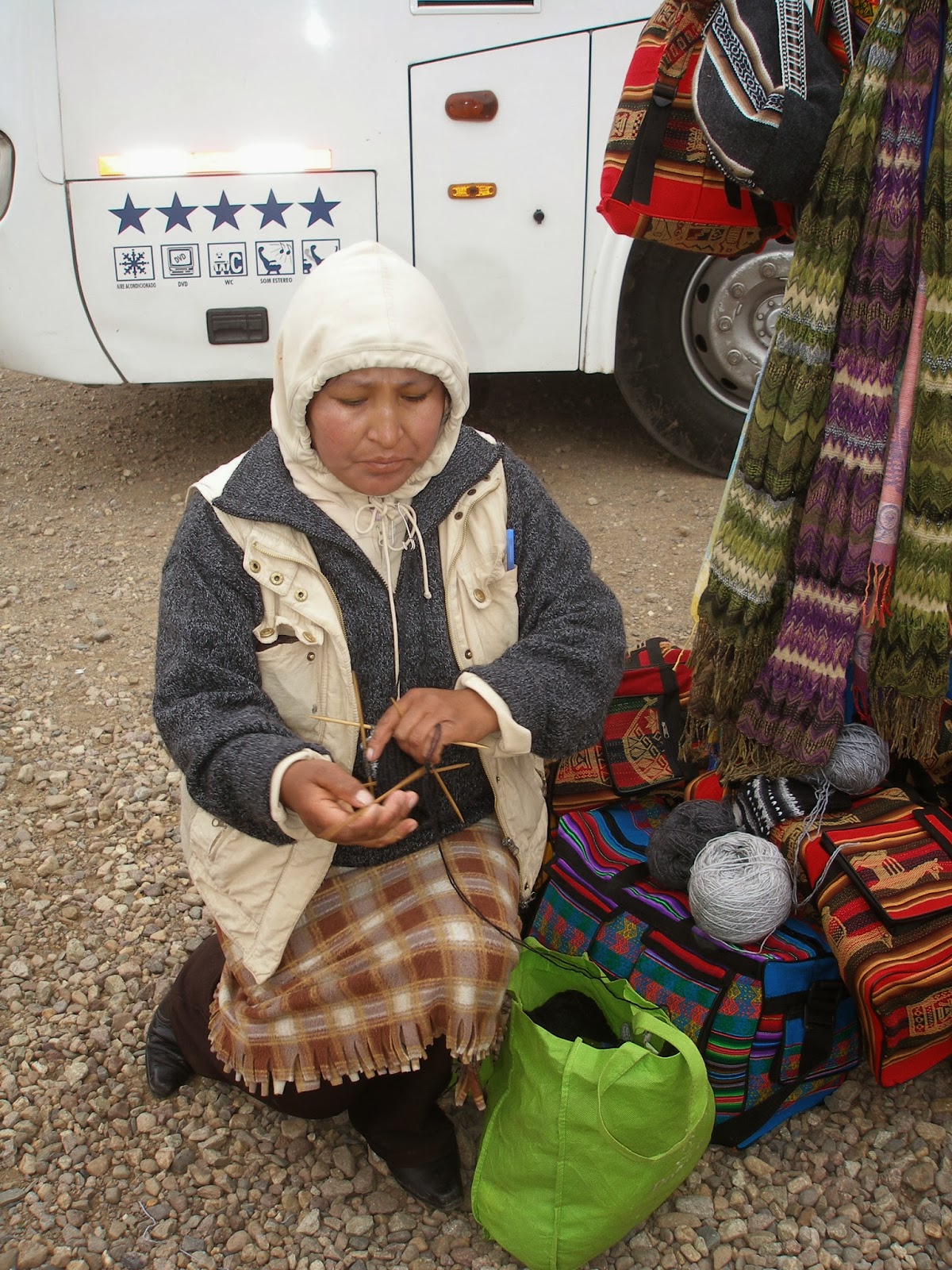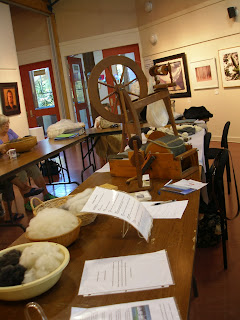My partner, John and I have just returned from an amazing visit to
Peru. The country has always been on my
radar but is not a place one can visit without support and John was not
interested in group tours. That is until
his Alma Mata (MIT) offered a small group tour lead by a Professor of Astronomy and built around the opportunity to explore the relationship of the various
Inca sites to the sun. The tour
fulfilled John’s scientific interests while providing me with further
opportunities to experience the vibrant colours of a culture where weaving and
knitting play an important role.
Starting in Lima, we visited Cusco, the Sacred Valley, Machu
Pichu, Lake Titicaca and then flew to Iquitos
and stayed in the Amazon Rainforest for a few days. Much has been written about all of these
places but nothing prepared me for the vibrancy of the colour and the
reflection of those colours in the daily life of indigenous people who are still practice their traditional
ways.
Machu Pichu
Machu Pichu was an
incredible place as were many of the other Inca sites. We spent two days touring the site and saw it in the moody cloud of approaching storms and the bright sunshine of a clearing sky. Sightings were taken along the way proving again that the Inca did have a special relationship with the sun.
Prof.Dr. Richard Binzel and guide, Haime taking sightings at Macu Pichu.
My Goodness. The Inca were right!
Of course, my favurite moments were spent in the women’s
weaving co-op in Chinchero in the Sacred Valley where we watched
a demonstration of traditional dying methods.
More particularly we were shown the uses of the cochineal beetle as a
source of the perfect red.
Demonstation of wool dying.
The women,
who still wear traditional dress, speak English and proudly demonstrate their
craft using back strap looms. In a small
market close by, I found a woman sitting on the ground with a variation of this
loom in which the warp was hooked over her foot. She was weaving a strap using a double weave
technique in which the warp was manipulated through heddles made of different
coloured yarn differentiating between the various patterns.
Demonstrating a drop spindle.
Note warped looms in the bacground.
Me receiving special instructions in how to use the dried beetle (cochineal) that I bought. Add lemon juice for orange and alum for purple!
Everywhere we travelled in the country, we saw women working
and if their hands were not busy then they were using their drop spindles and
spinning yarn.
A vendor knitting on the tourist stop at the highest point on the plateau (14,500+ ft) between Cusco and Puna (Lake Titicaca).
On Isla Taquile on Lake
Titicaca, it is the men who knit. Our
guide explained that, as a small boy his father taught him the craft and he was
eventually required to knit a hat in the traditional style with a colourful
band around the head, floppy ear pieces and a white top piece that fell
over to one side and which was embellished
with a colourful tassel. These colours
denoted his availability for marriage.
The hat was tightly knit. If he wanted to express interest in a
young woman he could present her with the hat.
She tested his knitting skill by filling it with water. If it leaked, she handed it back! This island has been declared a world
heritage site for its weaving and the role of textile in the cultural fabric of
daily life. The women are renowned for
their weaving and the intricate and delicate designs in their work.
Samples of the fine weaving from Isla Taquile.
Of course the famous Uros people of Lake Titicaca
demonstrate their own weaving arts in the creation of the floating reed islands
on which they live. These island people
rely on reeds for most of their existence as their homes; their boats, their
furniture and most of the fabric of their existence is dependent on woven
reeds.
Approaching a reed island on Lake Titicaca.
They also produce colourful
embroideries and their eye for colour is reflected in their dress of
multi-layered skirts and bright jackets, all topped with a bowler hat; a legacy
of British explorers.
A welcoming committee.
The men were fishing but the women made us welcome and proudly showed off their homes which are now equipped with satelite dishes and t.v. sets. They playfully dressed me up in local costume including colouful tassels for my braids denoting my availability.
Well, you can dress me up, but I am not sure you would want to take me out!
Note the home in the background made from reeds.
Next stop was the Amazon River, highway to the many small villages set in jungle landscape along its muddy banks. This tropical rainforest has no seasons; just high water when the snow melts in the Andes, and low water during winter season. As a result of climate change and the extensive glacial melt in the past
few years, the increased run-off has created some hardship for
villagers who's homes are regularly flooded during the time of high water.
Visiting a typical home along the Amazon River.
Note the corn, rice, yucca and other plants growing haphazardly around this house. No need for seasonal planting here as we found corn stalks in various stages of growth. Villagers mainly live on fish, corn and rice and other tropical fruits such as bananas, breadfruit, papaya, and citrus fruits.
We were also able to visit a school and meet the children who greeted us warmly and told us of their aspirations to be teachers, doctors, nurses and travel guides. Clearly, tourism is expected to play a major role in the future of Peru.
Some of the children at a school on the Amazon.
To fully appreciate the jungle, we were invited to walk high in the tree canopy above and to see a world unknown to those who prefer the jungle floor. In the bright sunshine, orchids and other brilliant flowers thrive on their host trees as do other jungle creatures such ad iguana and monkeys.
Our guide, Cesar walking in the high canopy of the jungle some110 ft above the jungle floor.
Despite what we would describe as poverty by western standards, our guides were all from the local communities and spoke several languages; most commonly one or both of the two main indigenous languages,and Spanish and English. They were all university trained to provide interpretive services to the growing tourism trade and all shared a universal love of their country and their communities. They were well informed about their history and even the local shaman knew all the botanical names of the herbs and plants he used in his practice. Like most other Peruvians, despite the remoteness of these communities, they all also have cell phones and are very much connected to the outside world.
The local Shaman ridding a fellow traveler of negative vibes.
He wore wellies,
camouflage shorts, a t-shirt from the 2002 walk for multiple sclerosis
and a feathered head dress and he carried a cell phone - a true
representative of contemporary Peru.
Sadly, tourism and technology are opening up
these spaces to the modern world and there is little likelihood those
traditions will survive over the next ten years. Despite the poverty, I sensed a degree of
contentment among the folks we met that is unmatched in North American
society. I expect that contentment will
dissipate as young people are exposed to the acquisitive values of western, contemporary society. Modern Peru (cities like Lima
and Cusco) are already being overtaken by McDonald’s and Starbucks. Can rural communities survive us all trooping
through in out air-conditioned coaches with our cameras ready for the many
opportunities to capture the’ quaintness’ of indigenous peoples lives?
For me, the memories of this visit to Peru are about
wonderful people, extraordinary sights and colour. And yes!
It was also about fibre.









































